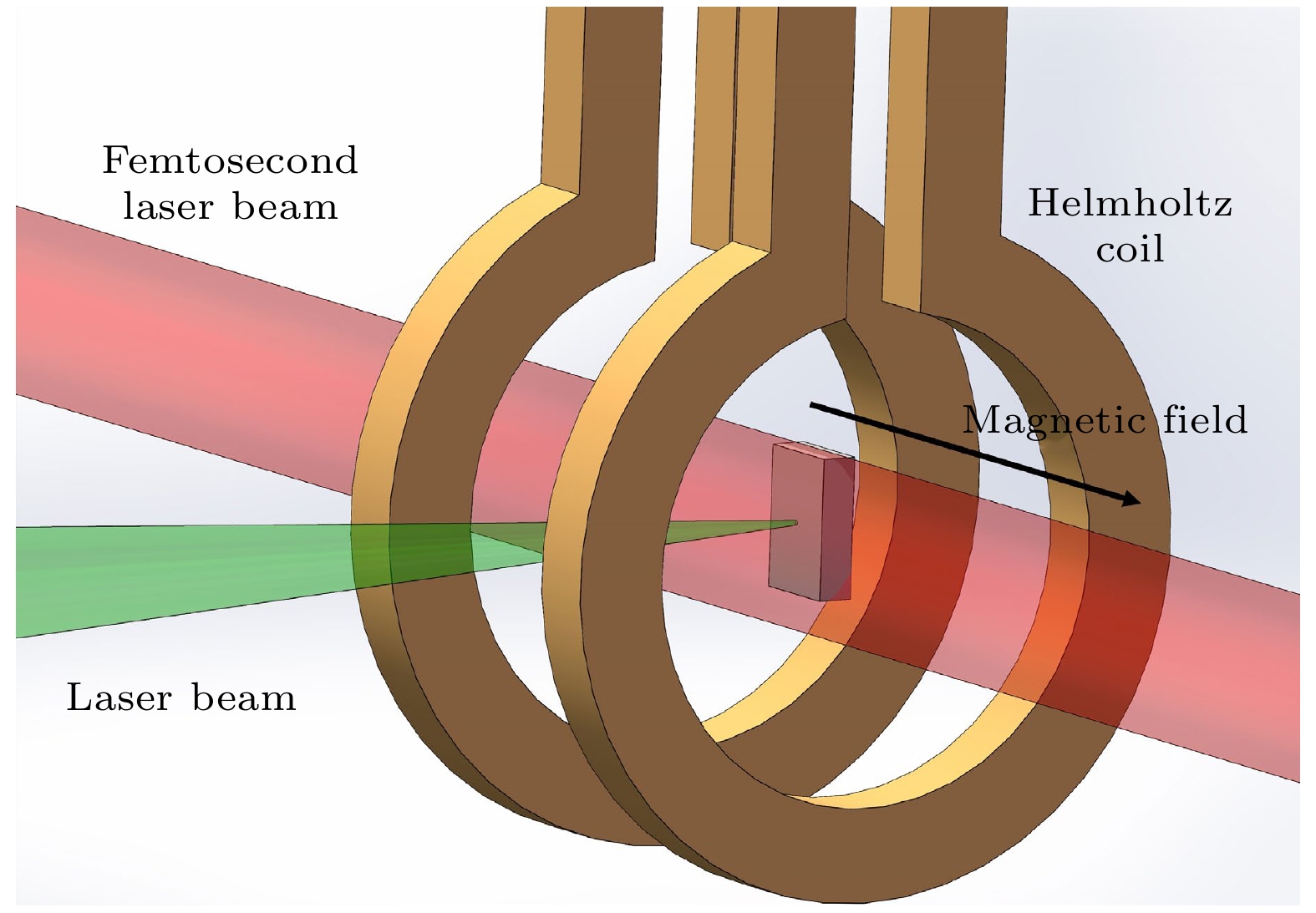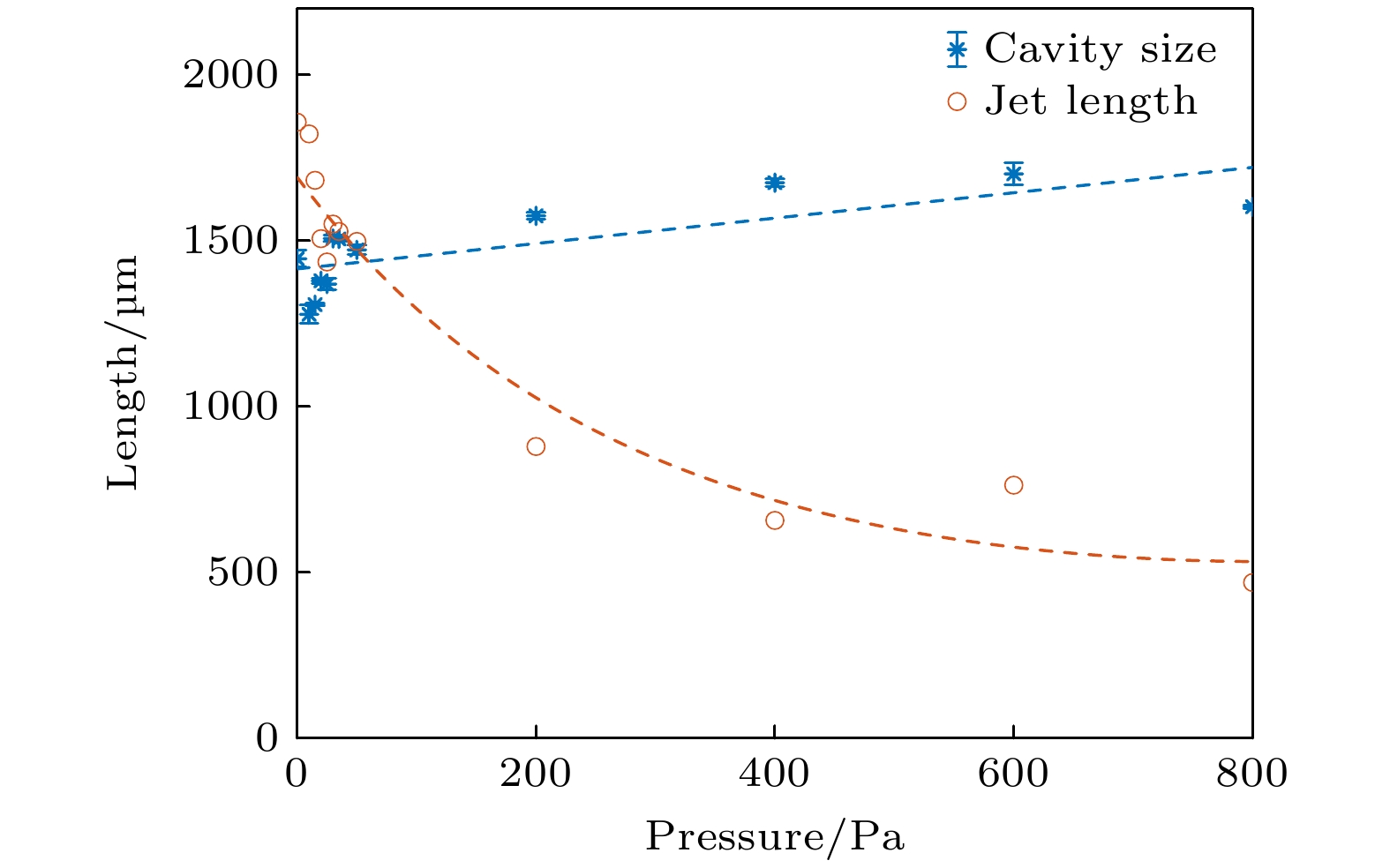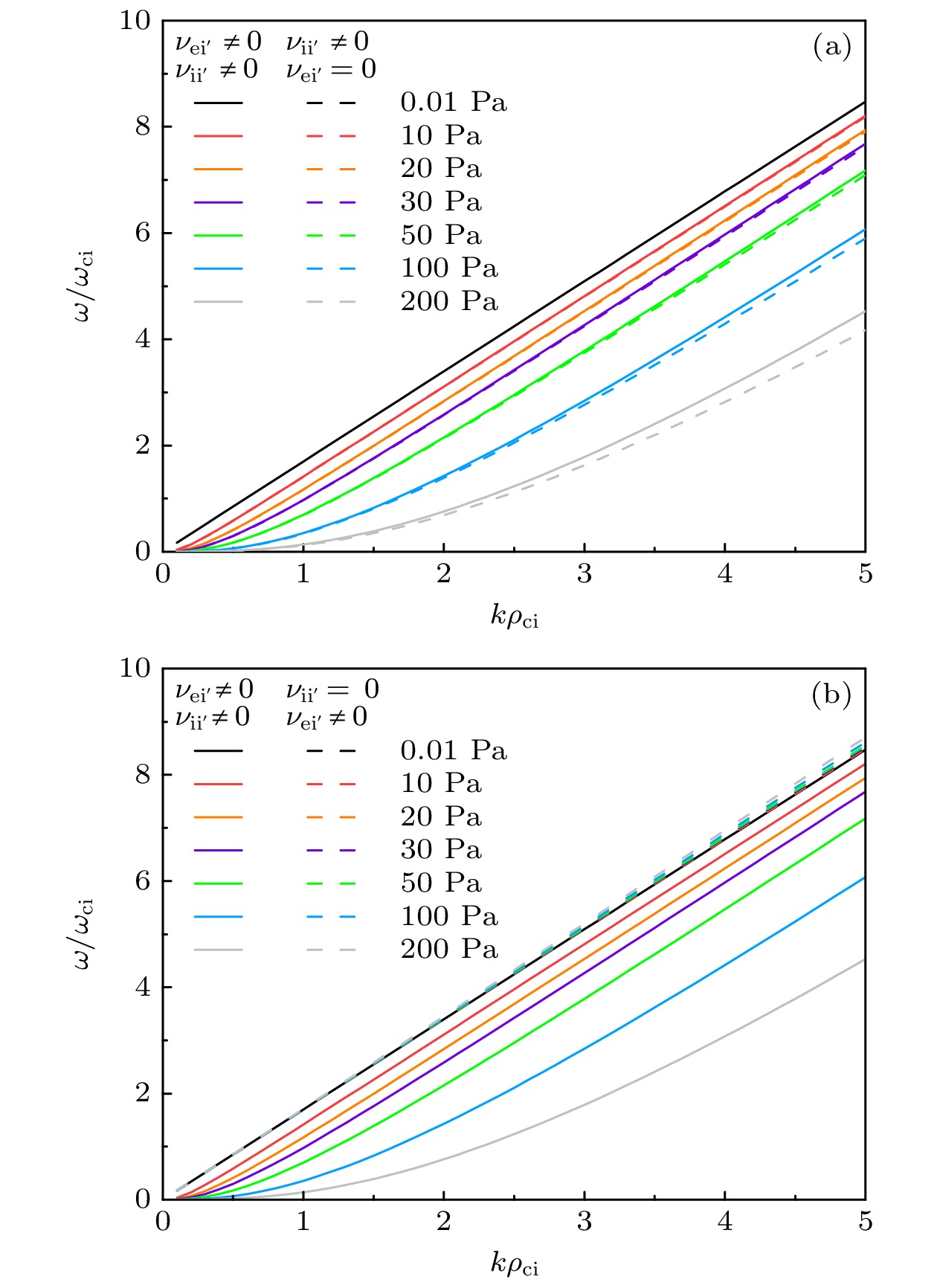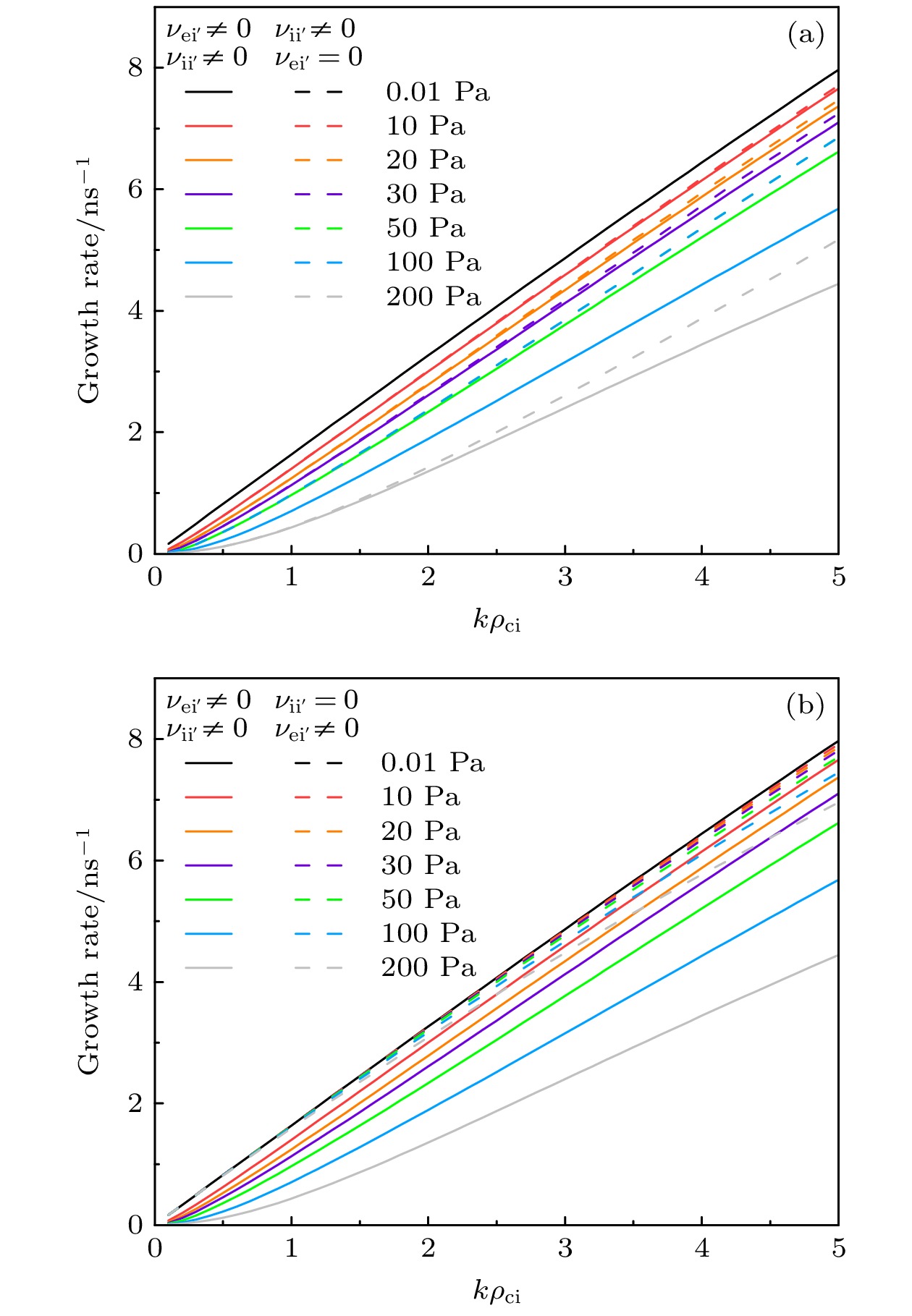-
Diamagnetic cavity and flute instability generated by plasma expansion in an external magnetic field are important phenomena in space and fusion physics. We use a nanosecond laser irradiated carbon planar target to generate plasma, and the plasma expands in a 7 T transverse pulsed magnetic field to produce diamagnetic cavity. The flute instabilities formed on the surface of the diamagnetic cavity are explored experimentally. Data analysis shows that, under our experimental parameters, the gyroradius of electron (
$ {\rho }_{{\rm{e}}} $ ) is much smaller than the density gradient scale length of the diamagnetic cavity ($ {L}_{{\rm{n}}} $ ), while the ion’s gyroradius ($ {\rho }_{{\rm{i}}} $ ) is much larger than$ {L}_{{\rm{n}}} $ , indicating that the electrons are magnetized while the ions are not. The relative drift between electrons and ions provides free energy for developing the flute instability, which is composed of gravity drift and diamagnetic drift. The calculation shows that the gravity drift velocity is much larger than the diamagnetic drift velocity in our experiment, so the instability belongs to the large Larmor radius instability. By filling the target chamber with rarefied helium ambient gas, we find that the flute instabilities are inhibited significantly. When the ambient gas pressure exceeds 50 Pa (about 1% of the interface plasma density of diamagnetic cavity), the flute instabilities are almost completely suppressed. Kinetic analyses show that ion-ion collision and electron-ion collision, especially the former, are the main effects that inhibit the development of instability. Our results are of benefit to laser fusion and address the fundamental question of explored space phenomena.-
Keywords:
- laser plasma /
- external magnetic field /
- diamagnetic cavity /
- flute instability
[1] Lühr H, Klöcker N, Acuña M H 1988 Adv. Space Res. 8 11
[2] Bernhardt P A 1992 Phys. Fluids B 4 2249
 Google Scholar
Google Scholar
[3] Valenzuela A, Haerendel G, Föppl H, Melzner F, Neuss H, Rieger E, Stöcker J, Bauer O, Höfner H, Loidl J 1986 Nature 320 700
 Google Scholar
Google Scholar
[4] Bernhardt P A, Roussel-Dupre R A, Pongratz M B, Haerendel G, Valenzuela A, Gurnett D A, Anderson R R 1987 J. Geophys. Res. Space Phys. 92 5777
 Google Scholar
Google Scholar
[5] Dimonte G, Wiley L G 1991 Phys. Rev. Lett. 67 1755
 Google Scholar
Google Scholar
[6] Peyser T A, Manka C K, Ripin B H, Ganguli G 1992 Phys. Fluids B 4 2448
 Google Scholar
Google Scholar
[7] Collette A, Gekelman W 2011 Phys. Plasmas 18 055705
 Google Scholar
Google Scholar
[8] Zakharov Y P 2002 Adv. Space. Res. 29 1335
 Google Scholar
Google Scholar
[9] Yao W P, Capitaine J, Khiar B, Vinci T, Burdonov K, Béard J, Fuchs J, Ciardi A 2022 Matter Radiat. Extremes 7 026903
 Google Scholar
Google Scholar
[10] Plechaty C, Presura R, Esaulov A A 2013 Phys. Rev. Lett. 111 185002
 Google Scholar
Google Scholar
[11] Ripin B H, McLean E A, Manka C K, Pawley C, Stamper J A, Peyser T A, Mostovych A N, Grun J, Hassam A B, Huba J D 1987 Phys. Rev. Lett. 59 2299
 Google Scholar
Google Scholar
[12] Brecht S H, Gladd N T 1992 IEEE Trans. Plasma Sci. 20 678
 Google Scholar
Google Scholar
[13] Tang H B, Hu G Y, Liang Y H, Wang Y L, Tao T, Hu P, Yuan P, Zhu P, Zuo Y, Zhao B, Zheng J 2020 Phys. Plasmas 27 022108
 Google Scholar
Google Scholar
[14] Tang H B, Hu G Y, Liang Y H, Tao T, Wang Y L, Hu P, Zhao B, Zheng J 2018 Plasma Phys. Controlled Fusion 60 055005
 Google Scholar
Google Scholar
[15] Hu P, Zhao J Y, Wang J C, Zhang Z C, Tang H B, Hu G Y 2022 J. Instrum. 17 P07036
 Google Scholar
Google Scholar
[16] Wang Y L, Hu G Y, Hu P, Liang Y H, Yuan P, Zheng J 2019 Rev. Sci. Instrum. 90 075108
 Google Scholar
Google Scholar
[17] Hu P, Hu G Y, Wang Y L, Tang H B, Zhang Z C, Zheng J 2020 Rev. Sci. Instrum. 91 014703
 Google Scholar
Google Scholar
[18] Hassam A B, Huba J D 1987 Geophys. Res. Lett. 14 60
 Google Scholar
Google Scholar
[19] Gisler G, Lemons D S 1989 J. Geophys. Res. Space Phys. 94 10145
 Google Scholar
Google Scholar
[20] Winske D 1988 J. Geophys. Res. Space Phys. 93 2539
 Google Scholar
Google Scholar
[21] Huba J D, Hassam A B, Winske D 1990 Phys. Fluids B 2 1676
 Google Scholar
Google Scholar
[22] Ali A W, McLean E A 1985 J. Quant. Spectrosc. Radiat. Transfer 33 381
 Google Scholar
Google Scholar
[23] Fiuza F, Swadling G F, Grassi A, et al. 2020 Nat. Phys. 16 916
 Google Scholar
Google Scholar
-
图 2 飞秒激光干涉测量的不同背景气压下碳等离子体在20 ns时刻形成的抗磁腔和槽纹不稳定性 (a) 真空背景(0.01 Pa); (b)—(l) 背景气体气压从10—800 Pa变化. 虚线位置为初始靶位, 其左侧是从干涉条纹图解相位时产生的无效数据
Fig. 2. Structures of diamagnetic cavity and flute instability at 20 ns after laser ablation measured by femtosecond laser optical interferometry: (a) Vacuum ambient at 0.01 Pa; (b)–(l) ambient helium gas with pressure from 10–800 Pa. The left side of dotted line (the target surface) is invalid data generated by the process of phase unwrapping from interferogram fringes.
图 7 密度梯度标长随气压的变化. 认为等离子体为球形膨胀, 选取打靶点为球心, 从 θ = 40°, 50°, 60°, 70°四个角度测量梯度标长
Fig. 7. Density gradient scale length at the surface of diamagnetic cavity vs. ambient gas pressure. Considering that the plasma expands spherically around the laser irradiated target, the gradient scale lengths are measured at four angles of θ = 40°, 50°, 60°, 70°.
图 8 不同气压时的不稳定性色散曲线, 实线同时包含离子-离子碰撞项和电子-离子碰撞项 (a) 虚线仅包含离子-离子碰撞; (b) 虚线仅包含电子-离子碰撞
Fig. 8. Instability dispersion curves at different gas pressures, the solid lines include both ion-ion and electron-ion collision effect: (a) Dashed lines include only the ion-ion collision; (b) dashed lines include only the electron-ion collision.
图 9 计算的不同气压时的不稳定性增长, 实线同时包含了离子-离子碰撞项和电子-离子碰撞项 (a) 虚线仅包含离子-离子碰撞项; (b) 虚线仅包含电子-离子碰撞
Fig. 9. Growth rates calculated at various gas pressure, the solid lines include both ion-ion and electron-ion collision effect: (a) Dashed lines include only the ion-ion collision; (b) dashed lines include only the electron-ion collision.
表 1 真空背景(0.01 Pa)时典型的等离子体参数
Table 1. Characteristic plasma parameters at vacuum (0.01 Pa) ambient conditions.
参数 符号 真空条件下的值 靶材料 — C 有效电荷数 Z 4.5 磁场强度/T B 7 界面电子密度/(1018 cm–3) ne 3 离子初始速度/(μm·ns–1) Vi0 150 电子温度/eV Te 20—50 离子温度/eV Ti 20—50 电子热速度/(μm·ns–1) Ve 2300 离子热速度/(μm·ns–1) Vi 15.5 不稳定性增长率/ns–1 γ 0.3 不稳定性波长(μm) λ 120 等效加速度/(μm·ns–2) g 5.8 密度梯度标长/μm Ln 300 等效“重力”漂移速度(μm·ns–1) Vg 23.1 抗磁漂移速度/(μm·ns–1) Vdi 2.5 总漂移速度/(μm·ns–1) VE 25.6 离子回旋半径/μm ρi 604 电子回旋半径/μm ρe 1.9 电子回旋频率/(1012 rad·s–1) ωce 1.2 离子回旋频率/(108 rad·s–1) ωci 2.5 低杂化频率/(106 rad·s–1) ωlh 3.6 电子等离子体频率/(1013 rad·s–1) ωpe 6.5 离子等离子体频率/(1011 rad·s–1) ωpi 9.3 磁约束半径/mm RB 1 背景气体密度/(1012 cm–3) nb 2.4 离子-离子碰撞频率/(105 s–1) $ {\nu }_{{\rm{i}}{\rm{i}}\text{'}} $ 5.1 电子-离子碰撞频率/(105 s–1) $ {\nu }_{{\rm{e}}{\rm{i}}\text{'}} $ 2.3 电子扩散系数/(105 μm2·s–1) De 4.1 -
[1] Lühr H, Klöcker N, Acuña M H 1988 Adv. Space Res. 8 11
[2] Bernhardt P A 1992 Phys. Fluids B 4 2249
 Google Scholar
Google Scholar
[3] Valenzuela A, Haerendel G, Föppl H, Melzner F, Neuss H, Rieger E, Stöcker J, Bauer O, Höfner H, Loidl J 1986 Nature 320 700
 Google Scholar
Google Scholar
[4] Bernhardt P A, Roussel-Dupre R A, Pongratz M B, Haerendel G, Valenzuela A, Gurnett D A, Anderson R R 1987 J. Geophys. Res. Space Phys. 92 5777
 Google Scholar
Google Scholar
[5] Dimonte G, Wiley L G 1991 Phys. Rev. Lett. 67 1755
 Google Scholar
Google Scholar
[6] Peyser T A, Manka C K, Ripin B H, Ganguli G 1992 Phys. Fluids B 4 2448
 Google Scholar
Google Scholar
[7] Collette A, Gekelman W 2011 Phys. Plasmas 18 055705
 Google Scholar
Google Scholar
[8] Zakharov Y P 2002 Adv. Space. Res. 29 1335
 Google Scholar
Google Scholar
[9] Yao W P, Capitaine J, Khiar B, Vinci T, Burdonov K, Béard J, Fuchs J, Ciardi A 2022 Matter Radiat. Extremes 7 026903
 Google Scholar
Google Scholar
[10] Plechaty C, Presura R, Esaulov A A 2013 Phys. Rev. Lett. 111 185002
 Google Scholar
Google Scholar
[11] Ripin B H, McLean E A, Manka C K, Pawley C, Stamper J A, Peyser T A, Mostovych A N, Grun J, Hassam A B, Huba J D 1987 Phys. Rev. Lett. 59 2299
 Google Scholar
Google Scholar
[12] Brecht S H, Gladd N T 1992 IEEE Trans. Plasma Sci. 20 678
 Google Scholar
Google Scholar
[13] Tang H B, Hu G Y, Liang Y H, Wang Y L, Tao T, Hu P, Yuan P, Zhu P, Zuo Y, Zhao B, Zheng J 2020 Phys. Plasmas 27 022108
 Google Scholar
Google Scholar
[14] Tang H B, Hu G Y, Liang Y H, Tao T, Wang Y L, Hu P, Zhao B, Zheng J 2018 Plasma Phys. Controlled Fusion 60 055005
 Google Scholar
Google Scholar
[15] Hu P, Zhao J Y, Wang J C, Zhang Z C, Tang H B, Hu G Y 2022 J. Instrum. 17 P07036
 Google Scholar
Google Scholar
[16] Wang Y L, Hu G Y, Hu P, Liang Y H, Yuan P, Zheng J 2019 Rev. Sci. Instrum. 90 075108
 Google Scholar
Google Scholar
[17] Hu P, Hu G Y, Wang Y L, Tang H B, Zhang Z C, Zheng J 2020 Rev. Sci. Instrum. 91 014703
 Google Scholar
Google Scholar
[18] Hassam A B, Huba J D 1987 Geophys. Res. Lett. 14 60
 Google Scholar
Google Scholar
[19] Gisler G, Lemons D S 1989 J. Geophys. Res. Space Phys. 94 10145
 Google Scholar
Google Scholar
[20] Winske D 1988 J. Geophys. Res. Space Phys. 93 2539
 Google Scholar
Google Scholar
[21] Huba J D, Hassam A B, Winske D 1990 Phys. Fluids B 2 1676
 Google Scholar
Google Scholar
[22] Ali A W, McLean E A 1985 J. Quant. Spectrosc. Radiat. Transfer 33 381
 Google Scholar
Google Scholar
[23] Fiuza F, Swadling G F, Grassi A, et al. 2020 Nat. Phys. 16 916
 Google Scholar
Google Scholar
计量
- 文章访问数: 4896
- PDF下载量: 106
- 被引次数: 0

















 下载:
下载:









